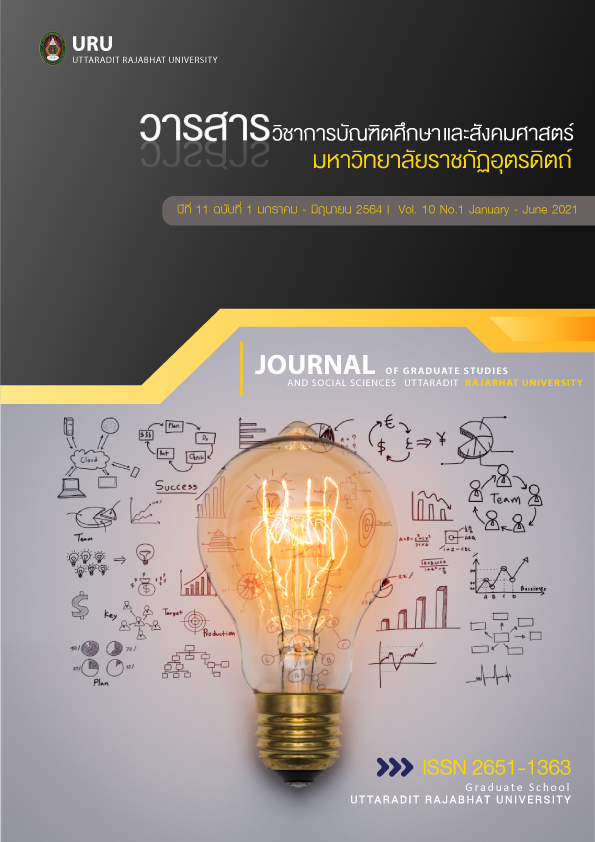EFFECT OF MODEL BASED LEARNING TOECLIPSES CONCEPTIONS OF LOWER SECONDARY SCHOOL STUDENTS’
Keywords:
Model-Based Learning, Scientific understanding, Normalized GainAbstract
The objective of this research is to study the scientific conceptual change of eclipses of lower secondary school after learning by using a learning unit designed by model-based learning method. The samples were grade 9 students of Vachiralai School, Saraphi District, Chiang Mai province, this research was provided in the second semester of the academic year 2019. The research instruments were composed of 1. lesson plans designed by using model-based methods 2. basic astronomy conceptual test. The results of the research revealed that, the level of understanding of concepts eclipse of students taught by using the model-based learning method was higher than before learning. The students ’average level of understanding of all about eclipses concepts increased from 0.00 percent to 64.28 percent after learning. And the analysis of the actual learning outcomes (Normalized Gain) of the students taught by using model-based learning method found that the Normalized Gain equal to 0.78, indicating that the development of understanding was at a high level.
References
พิทักษ์พงษ์ สมปาน และกรีฑา แก้วคง. (2561). มโนทัศน์ของนักเรียนระดับชั้นมัธยมศึกษาปีที่ 3 เกี่ยวกับการเกิดฤดู. วารสารวิทยาศาสตร์และวิทยาศาสตร์ศึกษา,1(2), 162-170.
วสุพงษ์ อิวาง และ กรีฑา แก้วคง. (2562). มโนทัศน์ดาราศาสตร์พื้นฐานของนักเรียนระดับชั้นประถมศึกษา: กรณีศึกษากลุ่มชาติพันธุ์ม้ง. วารสารครุศาสตร์, 47(3), 384-403.
สถาบันการทดสอบทางการศึกษาแห่งชาติ (องค์การมหาชน). (2561). รายงานผลการทดสอบทางการศึกษาขั้นพื้นฐาน (O-NET) ชั้นมัธยมศึกษาปีที่ 3. สืบค้น 1 ตุลาคม 2562, จาก http://www.niets.or.th
สุวิทย์ คงภักดี. (2553). ผลของการสอนดาราศาสตร์แบบสืบเสาะโดยใช้นวัตกรรมแบบจำลองระบบโลก ดวงจันทร์ ดวงอาทิตย์. (วิทยานิพนธ์ปริญญามหาบัณฑิต). กรุงเทพฯ: มหาวิทยาลัยศรีนครินทรวิโรฒ.
Artdej R., Meela P., & Sriboonlert S. (2014). The role of model-based inquiry in supporting students’ conceptual understanding. Proceedings of the Australian Conference on Science and Mathematics Education, 112- 119.
CAER (Collaboration for Astronomy Education Research). (1999). Astronomy Diagnostic Test V 2.0. สืบค้น 29 พฤษภาคม 2562, จาก http://solar.physics.montana.edu/aae/adt/.
Chih-Chiang, Y. and Jeng-Fung, H. (2012). Using Conceptual Change Theories to Model Position Concepts in Astronomy. US-China Education Review, 11, 917-931.
Diakidoy and Kendeou. (2001). Facilitating conceptual change in astronomy: A comparison of the effectiveness of two instructional approaches. Learning and Instruction, 11, 1-20.
Feral Ogan-Bekiroglu. (2007). Effects of Model-based Teaching on Pre-service Physics Teachers’ Conceptions of the Moon, Moon Phases, and Other Lunar Phenomena. International Journal of Science Education, 29, 555-593.
Gobert and Buckley. (2000). Introduction to model-based teaching and learning in science education. International Journal of Science Education, 22, 891-894.
Haristiani, Aryanti, Nandiyanto, Sofiani. (2017). Myths, Islamic View, and Science Concepts: The Constructed Education and Knowledge of Solar Eclipse in Indonesia. Journal of Turkish Science Education, 14, 35-47.
Joanne Rosvick. (2008). An interactive Demonstration of Solar and Lunar Eclipses. The Astronomy Education Review, 7, 112-121.
Justi R.S. and Gilbert J.K. (2002). Models and Modelling: Routes to More Authentic Science Education. International Journal of Science and Mathematics Education, 2, 115-130.
Mark Guy and Timothy Young. (2010). Creating Eclipses: Using Scale Models to Explore How Eclipses Happen. Science Activities, 47, 75-82.
Oh, P. S., & Oh, S. J. (2011). What teachers of science need to know about models: an overview. International Journal of Science Education, 33(8), 1109-1130.
Richard R. Hake. (1998). Interactive-engagement versus traditional methods: A six-thousand-student survey of mechanics test data for introductory physics courses. American Journal of Physics, 66, 64-74.
Sarioglan and Uysal. (2019). Effect of Technology-Integrated Inquiry Based Learning Approach on Middle-School Students’ Conceptual Understanding of Lunar Eclipse.The Eurasia Proceedings of Educational & Social Sciences, 14, 27-33
Semercioglu. (2021). Understanding of teachers on phases of the moon and the lunar eclipse. European Journal of Education Studies, 8, 102-131.
Shawn Stover and Gerry Saunders. (2000). Astronomical misconceptions and the effectiveness of science museums in promoting conceptual change. Journal of Elementary Science Education, 12, 41-51.
Trumper, R. (2001). A cross-age study of junior high school students’ conceptions of basic astronomy concepts. International Journal of Science Education, 23(11), 1111-1123.
Downloads
Published
How to Cite
Issue
Section
License
แนวคิดและทัศนะในบทความเป็นความรับผิดชอบของผู้เขียนบทความ การนำบทความหรือส่วนหนึ่งของบทความไปตีพิมพ์เผยแพร่ ให้อ้างอิงแสดงที่มา และข้อมูลเกี่ยวกับผู้เขียนบทความ




